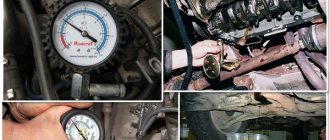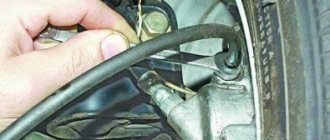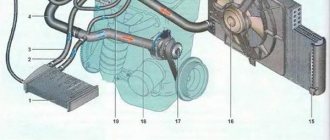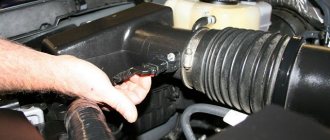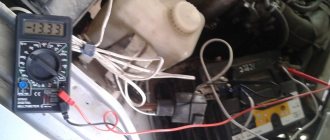Many motorists driving a Lada Priora encounter some problems after using it for a long time. Priora consumes oil - this malfunction occurs more often than others.
High oil consumption should alert the driver and serve as a reason to send his own car for diagnostics to a specialized service center.
Purpose of motor oil
The operating manual of any machine contains information about oil consumption. Lubricating fluid allows all car components to operate fully and efficiently. When driving, many interconnected processes take place in the engine.
Friction appears between contacting parts, which has a destructive effect on motor parts. Motor oil reduces the negative effects of friction and wear of spare parts.
With increased Priora oil consumption, the contacting parts are not able to properly perform their task. They are subject to abrasion, the engine jams and breaks. In order for the machine to operate continuously and for a long time, it is necessary to control the volume of oil fluid.
Recommended oil characteristics
Priora is equipped with several engines: 8 and 16-valve with a volume of 1.6 liters, as well as the above-described 1.8-liter with 16 valves. They all have different power - from 81 to 120 horses. In order to choose the right lubricant for them, it must meet certain characteristics. The lubricant must be synthetic or semi-synthetic. So what kind of oil should I use? Lada Priora uses engine oil corresponding to classes SJ, SL - according to the American API specification. Such lubricants have been used for gasoline engines since 1996. Which oil is better to fill - SJ or SL?
Lubricants of level SL and higher are required to be used in 16-valve engine models. They are designed for both conventional and multi-valve engines, including turbocharged ones. These oil compositions have low volatility and extended drain intervals. Good cleaning qualities allow you to promptly remove carbon deposits, soot, and other harmful deposits from the engine. SL class motor oils can be recommended for all Priora power units.
Another important characteristic is viscosity, defined by the SAE standard. As a rule, all-season motor fluids that have a certain level of low-temperature and high-temperature viscosity are poured. For example, in the 5W30 indicator, the number 5 means that the pumpability of the lubricant, as well as the engine crankability, will allow a cold engine to be started normally at sub-zero temperatures, down to -30°C. The number 30 after the letter W determines the kinematic and dynamic viscosity of the lubricating mixture in a warm, running engine. It is usually measured in laboratory conditions, the oil composition is heated to temperatures of +40°C, as well as +100°C. Although the cylinder-piston group heats up even to +250°C, engine oil also works there, reducing the friction of the piston rings on the cylinder walls.
Why is lubricant quickly used up?
"Priora", despite its modern engine, "eats" a lot of oil. The reasons for this are as follows:
- the appearance of a leak;
- wear of spare parts;
- low quality motor oil;
- exceeded operating period;
- burning of oil liquid.
Often, car oil leaks occur due to poor crankcase ventilation. This happens because the exhaust enters the crankcase through the piston rings. Gases create increased compression, which disrupts the normal flow of processes in the unit. The oil is simply squeezed out of the engine.
Why do Priors eat oil, besides the reasons listed above? Oil is probably leaking from the valve plug or oil filter. To eliminate such leaks, the lining must be replaced. Constant vibration exposure, high loads, trips over rough terrain - all this causes various leaks.
Oil leaking from under the engine
Synthetics have good viscosity characteristics, ensuring the uninterrupted functioning of all units. It contains many additives that soften and partially eliminate the consequences of the negative impact on the power unit.
May be interesting: Checking the oil level in the automatic transmission
Mineral water does not have the advantages of synthetics. It pollutes the lubricating complex with its own combustion products. As a result, it turns out that the car “eats” oil.
An excessive operating period may also be the reason that the machine eats oil. Since the characteristics of the motor oil deteriorate during operation, some of the lubricant evaporates and burns out.
This negatively affects the car engine. Timely measures taken will allow the power unit to operate without failures for a long time.
Reason #1
If, after the engine has been idling for several minutes, you press the gas pedal to the floor several times, a thick cloud of bluish smoke may escape from the chimney. As the number of presses increases, the smoke will disappear, but this is one of the signs of engine malfunction. The reason is the valve stem seals.
An oil leak while the engine is running in idle mode and then its sudden combustion in the cylinders leads to the appearance of this thick smoky cloud and an increase in oil consumption. But replacing the caps cannot always solve this problem. Sometimes, if a Priora consumes oil, the reasons may be in the valve bushings. Experts recommend changing them along with the valve stem seals.
Oil waste
The car can “eat” consumables due to burnout. This is due to the fact that the oil indicators do not correspond to the characteristics of a particular engine. An excessively liquid oil product will remain in the cylinder block and burn out. And if it is too thick, it will envelop the moving parts with a dense film, significantly complicating their movement.
All this will lead to increased oil costs. In view of this, you need to use only the lubricant recommended by the car manufacturer.
Severe burnout can occur due to worn valve seals. Identifying this problem is quite difficult. To prevent the lubricant from smoking, that is, to stop burning, the seals need to be replaced. The piston rings also need to be changed. If they wear out significantly, engine repair may be required.
What is increased consumption
By the term “eating oil”, car owners mean increased consumption of lubricating motor fluids.
Often, during normal operation, such waste should not occur - the standards established by the manufacturer will be observed if there are no problems. If the technical documentation for the car states that replacement should be carried out once every 10 thousand kilometers, and the driver has to top it up more often, then this is an increased consumption.
Violation of the tightness of sealing joints in the form of oil seals or gaskets
The appearance of oil from under the valve covers or cylinder head gasket. Where oil leaks, it mixes with dust and forms a characteristic coating. There can be several reasons for a leak:
- Failure of the gasket itself, since the product is rubber. The repair is not difficult, but requires care when tightening the bolts.
- The appearance of oil under the gaskets is caused by an increase in pressure in the engine lubrication system. There may be four reasons here:
- The first and most important is the failure of the oil pump pressure reducing valve, which maintains the pressure within certain limits. It can only be repaired by replacing this device.
- Second, use very viscous oil. Do not skimp on oil; fill in the oil specified in the service book by the car manufacturer.
- Third, clogged oil channels (for worn engines). Occurs when using various flushing liquids of dubious purpose (meaning “decarbonization”).
- Fourth, a violation of crankcase ventilation, in which gases accumulate under the valve cover and oil pressure begins to increase, oil appears in the air filter. Cause: The separator screen is clogged and needs to be cleaned.
- The appearance of oil leakage from under the seals. There are three reasons for this malfunction:
- First, the oil seal simply wore out over time.
- Second, the pressure in the car’s lubrication system is increased.
- The third option is the hardest. The rotating parts of the power unit wear out in the form of bearings, rings, half rings, etc. In this case, the alignment of the units is disrupted and the parts become distorted. There is no need to replace the oil seals in case of this malfunction; this will only give a temporary effect. The intervention of an engine repair specialist will be required.
You may be interested: What is the best engine oil to put into a VAZ engine?
Engine tuning Priora 21126 1.6 16V
Chip tuning of the Priora engine
For fun, you can play with the sports firmware, but there will be no obvious improvement; see how to properly increase the power below.
Priora engine tuning for the city
There are legends that the Priora’s engine produces 105, 110 and even 120 hp, and the power was underestimated to reduce taxes, various measurements were even taken in which the car produced similar power... what everyone decides to believe, let’s focus on the indicators declared by the manufacturer. So, how to increase the power of a Priora engine, how to charge it without resorting to anything special, for a small increase you need to let the engine breathe freely. We install a receiver, a 4-2-1 exhaust, a 54-56 mm throttle body, and we get about 120 hp, which is quite good for the city. Boosting the Priora engine will not be complete without sports camshafts, for example, STI-3 camshafts with the configuration described above will provide about 140 hp. and it will be fast, an excellent city motor. The refinement of the Priora engine goes further, sawn cylinder head, Stolnikov 9.15 316 shafts, light valves, 440cc injectors and your car easily produces more than 150-160 hp.
Compressor for Priora
An alternative method of obtaining such power is to install a compressor, for example, the most popular option is an Auto Turbo kit based on PK-23-1, this compressor is easily installed on a 16-valve Priora engine, but with a lower compression ratio. Then there are 3 options: 1. The most popular, lower the coolant gasket with a gasket from a twelve-wheeler, install this compressor, exhaust on 51 pipes, Bosch 107 injectors, install it and go to the track to watch the car go down. But the car doesn’t run very well... then running to sell the compressor, writing that the Autoturbo doesn’t work and all that... is not our option. 2. We lower the coolant by installing a thick cylinder head gasket from 2112, for a St. Petersburg supercharger at a pressure of 0.5 bar this will be enough, we select the optimal narrow-phase shafts (Nuzhdin 8.8 or similar), exhaust 51 pipes, Volga BOSCH 107 injectors, receiver and throttle valve standard. To fully push the configuration, we give the cylinder head to cut the channels, install larger lightweight valves, this is not expensive and will provide additional power throughout the entire range. This whole thing needs to be configured online! We’ll get an excellent engine that can perform in any (!) range with a power of more than 150-160 hp.3. We lower the coolant by replacing the piston with a tuning one for the turbo, you can put a proven Nivov piston with a puddle under the turbo on 2110 connecting rods, on such a config you can put a more efficient compressor, a Mercedes one for example, blowing 1-1.5 bar with a power well over 200+ hp . and act like the devil! ) The advantage of the config is the ability to install a turbine on it in the future and blow out at least all 300+ hp. if the piston doesn't go to hell))
Boring the Priora engine or how to increase the volume
Let's start with how you don't need to increase the volume, an example would be the famous VAZ 21128 engine, don't do that)). One of the easiest options to increase volume is to install a motorcycle kit, for example STI, we choose it for our 197.1 mm block, but do not forget about the jambs of the 128 engine, do not rush to install a long-stroke elbow. You can go the other way and purchase a high block 199.5 mm Priora, 80 mm crankshaft, bore the cylinders to 84 mm and a connecting rod 135.1 mm pin 19 mm, this will give a total of 1.8 volume and without damage to R/S, the engine can be twist freely, install evil shafts and squeeze out more power than a regular 1.6l. To spin your engine even more, you can build up a standard block with a plate, how to do this, how it spins on a 4-throttle intake and wide shafts, and most importantly, how it runs is shown in the video below, watch:
Attention MAT (18+)
Priora on throttles
To increase the stability of the engine and the response of the gas pedal, 4 throttle bodies are installed on the intake. The bottom line is that each cylinder receives its own throttle valve and, thanks to this, resonant air vibrations between the cylinders disappear. We have more stable engine operation from bottom to top. The most popular method is to install a 4-throttle intake from Toyota Levin on a VAZ. You need to purchase: the unit itself, make an adapter manifold and pipes, in addition to this you need a nulevik filter, Bosch 360cc injectors, DBP (absolute pressure sensor), fuel pressure regulator, wide shafts (phase over 300), sawing cylinder head channels 40/35, light valves, Opel springs, rigid pushers, spider exhaust 4-2-1 on 51 pipes, or better yet, on 63 pipes. There are ready-made 4-throttle intake kits on sale that are quite suitable for use. With the correct prior configuration, the engine produces about 180-200 hp. and more. To go beyond 200 hp. on a VAZ atmosphere, you need to take shafts like STI Sport 8 and spin them at 10,000 rpm, your engine will produce more than 220-230 hp. and this will be a completely hellish drag cramp. The disadvantages of chokes include a reduction in engine life and this is not surprising, because even city engines on pipes spin at more than 8000-9000 rpm or more, so you cannot avoid constant breakdowns and repairs of the 21126 Priora engine.
Priora turbo engine
There are many methods for building a turbo Prior, let's look at the urban version as it is more suitable for use. Such options are most often built on a TD04L turbine, Niva pistons with grooves, ideally Stolnikov 8.9 shafts, USA 9.12 or similar, 440cc injectors, 128 receiver, 56 damper, exhaust on a 63 mm pipe. All this junk will give more than 250 hp, and how it will go, watch the video
Attention MAT (18+)
What about the serious Valilov? To build such engines, we leave the bottom the same on a reinforced block, sawn head, Nuzhdin 9.6 shafts or similar, rigid studs from the 8th valve, pump more than 300 l/h, injectors plus or minus 800cc, install the turbine TD05, direct-flow exhaust on the 63rd pipe. This set of iron will be able to pump 400-420 hp into your Prior motor; for a light car weighing a little more than a ton, this is enough to fly into space)
ENGINE RATING: 3+
<<BACK
Damage to power plant mechanisms
Damage to the power plant mechanisms responsible for proper mixture formation and oil separation in the combustion chamber (piston scuffing, oil scraper rings sticking, valve burnout, disappearance of honing, etc.)
In this case, the oil enters the combustion chamber of the car, where it mixes with fuel and air vapors and burns completely. Oil consumption with such a malfunction can be enormous, more than 1 liter per 1 km. Black smoke begins to pour out of the exhaust pipe. This malfunction is caused by driving on a “cold” engine.
After 50-60 cold starts, honing sets the oil scraper rings with locks in one direction, the seal is broken and oil consumption increases. The skirt comes off the pistons, the valves burn out, the oil seals become hard. There is only one treatment - engine overhaul.
Troubleshooting Methods
The first thing to do is to find possible leaks by carefully inspecting the valve cover. If there are leaks on the engine oil pan, drain the oil, then unscrew the pan and change its gasket, preferably placing it on sealant. If there is a leak through the crankshaft seals, replacing them yourself will be very problematic. It is better to carry out repairs at a service station.
Another reason for increased consumption may be a clogged crankcase ventilation system. Over time, resin deposits and carbon products are deposited on the walls of the pipe, which makes it difficult to remove gases that have escaped from the combustion chamber. This creates excess pressure in the crankcase, which forces oil through the seals and seals. Oil mist will enter the combustion chamber in excess through the ventilation system and intake manifold, which will lead to a decrease in the calorific value of the fuel and loss of engine power. To prevent this problem, it is necessary to regularly clean the ventilation system pipes: approximately every 50 thousand kilometers.
You should be careful about the quality of the lubricants used. They must comply with those recommended by the manufacturer, taking into account the climatic zone of the vehicle's operation. By following all the necessary recommendations, eliminating the indicated malfunctions and abandoning an aggressive driving style, you can significantly reduce the consumption of fuel and lubricants in your car.
Oil leak through breather
Oil loss through the breather is a very unpleasant problem. A breather is a device that compares the crankcase pressure of a power plant with atmospheric pressure. Without it, air would not get into the engine at all. Reasons for this malfunction:
- Air filter condition. The engine simply doesn't have enough air.
- Filling the lubrication system above a certain level. The excess is simply squeezed out through the breather.
- Worn oil scraper rings. As a result, excess pressure appears in the engine crankcase, which expels oil through the breather.
If the first two faults are easy to deal with, then the third one will have to go to a service station. Very rarely, the oil deflector rod may become clogged. In this case, gasoline and oil vapors do not pass into the oil separator, but are deposited in the breather, and a characteristic smell of gasoline is present.
Reasons for increased consumption
Several can be highlighted. The most common is wear of the valve stem seals. They are installed in the gas distribution mechanism.
Problems with caps should be solved very carefully, despite their simplicity. So, these elements are made of rubber - it can harden. This probability increases significantly if the engine does not warm up well. “Priors” with high mileage often suffer from this. The cuff (if it is frozen) will not be able to fit tightly into its seat - because of this, the oil will enter the valve sleeve without any obstacles. As a result, the lubricant will enter the cylinders, where it will burn safely. Oil can also get into the exhaust system. There will be characteristic blue smoke.
Conclusion
The choice of oil for the car must correspond to that recommended in the operating instructions. Replace filters in a timely manner and monitor the condition of the coolant.
Be sure to warm up a cold engine, especially in winter. Do not use flushing fluids from unknown manufacturers. With this approach, the heart of your car will work for a long time and without loss of oil.
Died
I love cars in all forms. I've been tinkering under the hood since childhood. I know all the ins and outs of Russian cars and some imported ones. I will be happy to share my knowledge with everyone who likes to do everything with their own hands.
How to change the oil mixture in Lada Priora
If the car’s warranty has already expired and there is no need to carry out scheduled maintenance at the dealer, in Lada Priora you can change the engine oil yourself. This process is simple. You just need to follow a certain sequence of actions. You must purchase in advance a 4-liter canister of motor fluid with suitable properties, as well as an oil filter. If you are going to switch to a different viscosity or change manufacturer, you will additionally need to flush the engine.
Soft flushes, according to the conditions of their use, are poured 200–300 kilometers before changing the lubricant. During this time, they clean the engine of toxins. Others pour right before you change the oil. Then the engine idles for 5 minutes to half an hour. It all depends on the specific wash. You should prepare: your own set of wrenches, a container for used lubricant, rags.
- The engine warms up well, the car is placed on a lift or over an inspection hole.
- The filler neck under the hood is released. The drain plug is carefully unscrewed with a 17 key, and a container for draining is first placed in the bottom of the crankcase.
- The old oil is completely drained along with the flush. It is advisable to suck out the remaining lubricant from the bottom with a large syringe with a tube - after all, it is very difficult to park the car in an absolutely horizontal position.
- The old oil filter is unscrewed. A new one is installed, half filled with new grease.
- The drain plug is screwed in and about 3.5 liters of lubricant flows into the engine through the filler neck. The level is checked with a dipstick; it should be halfway between MIN and MAX.
- The engine starts and idles. After 5–7 minutes, the oil level is checked again. Top up if necessary.
Your car is ready to travel again until the next consumable replacement.




